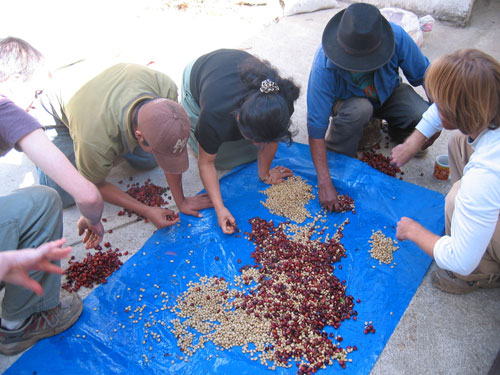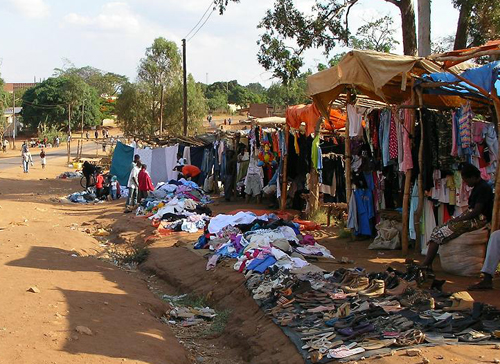7.3: Fair-trade and Informal Economies.
- Last updated
- Save as PDF
- Page ID
- 56424
FAIR-TRADE COFFEE GROWERS: 21ST CENTURY PEASANTS
Small-scale, semi-subsistence farmers make up the largest single group of people on the planet today. Once known as peasants, these people pose an interesting conundrum to economic anthropologists because they live their lives both inside and outside of global capitalism and state societies. These farmers primarily use their own labor to grow the food their families eat. They might also produce some type of commodity for sale. For example, many of the indigenous corn farmers in southern Mexico and Central America discussed earlier also produce small amounts of coffee that they sell in order to earn money to buy school supplies for their children, building supplies for their homes, clothing, and other things that they cannot produce themselves.
There are between 20 and 25 million small farmers growing coffee in more than 50 countries around the world. A portion of these small coffee farmers are organized into cooperatives in order to collectively sell their coffee as fair-trade certified. Fair trade is a trading partnership, based on dialogue, transparency, and respect, that seeks greater equity in international trade. According to Fairtrade International, fair trade supports farmers and workers to combat poverty and strengthen their livelihoods by establishing a minimum price for as many fair-trade products as possible; providing, on top of stable prices, a fair-trade premium; improving the terms of trade for farmers by providing access to information, clear contracts with pre-payments, access to markets and financing; and promoting better living wages and working conditions.[10] In order to certify their coffee, small farmers must belong to democratically run producers’ associations in which participation is open to all eligible growers, regardless of ethnicity, gender, religion, or political affiliation.
To better understand how indigenous farmers practice kin-organized subsistence maize production while simultaneously producing an agricultural commodity for global markets, I conducted long-term research in a highland Guatemala community.[11] In 1977 a small number of Tz’utujil Maya coffee farmers formed a cooperative, La Voz Que Clama en el Desierto (A Voice Crying Out in the Wilderness), with the goal of securing higher prices for their agricultural products and escaping the severe poverty they struggled against on a daily basis. Since the early 1990s the group has produced high-quality organic and fair-trade certified coffee for the U.S. market.
The farmers work tirelessly to ensure that their families have sufficient corn to eat and that their coffee meets the cooperative’s high standards of quality. The members of La Voz refer to their coffee trees as their “children” who they have lovingly tended for decades. High-quality, organic coffee production is time consuming and arduous—it requires almost daily attention. During the coffee harvest between December and March, wives, husbands, and children work together to pick the coffee cherries by hand as they ripen and carry them to the wet mill each afternoon.

While these farmers are producing a product for the global market, it is not strictly a capitalist mode of production. They own their own land and they sell the fruits of their labor for guaranteed prices. They also work cooperatively with one another, pooling and exchanging their labor, in order to guarantee the smooth functioning of their organization. This cooperation, while essential, is hard work. Because the fair-trade system does not rely on anonymous market exchanges, members of La Voz must also dedicate time to nurturing their relationships with the coffee importers, roasters, advocates, and consumers who support all their hard work through promotion and purchases. This means attending receptions when buyers visit, dressing up in traditional clothing to pick coffee on film for marketing materials, and putting up with questions from nosy anthropologists.
Because the coffee farmers also produce much of the food their families consume, they enjoy a great deal of flexibility. In times of hardship, they can redirect their labor to other activities by intensifying corn production, migrating in search of wage labor, or planting other crops. Their ultimate goal is to maintain the family’s economic autonomy, which is rooted in ownership of the means of production—in this case, their land. A close examination of these farmers’ lives reveals that they are not relics of a precapitalist system. Instead, their economic activity is uniquely adapted to the contemporary global economy in order to ensure their long-term survival.
SALAULA IN ZAMBIA: THE INFORMAL ECONOMY
The informal economy includes a diverse range of activities that are unregulated (and untaxed) by the state: rickshaw pullers in Calcutta, street vendors in Mexico City, and scrap-metal recyclers in Lexington, Kentucky, are all considered informal workers. Informal economies include people who are informally self-employed and those working informally for other people’s enterprises. In some parts of the world the informal economy is a significant source of income and revenue. In Sub-Saharan Africa, for example, the informal economy generates nearly 40 percent as much revenue as that included in the “official” gross domestic product.[12] Consequently, the informal economy is of great interest to economic anthropologists. However, the term “informal economy” is critiqued by some scholars since often what we refer to as informal economies are actually quite formal and organized, even though this organization is not regulated by the state and may be based on an internal logic that makes the most sense to those who participate in the exchanges.
Karen Hansen provides an in-depth look at the lives of vendors in the salaula, the secondhand clothing markets in Zambia in southern Africa.[13] Salaula, a term that literally means “to rummage through a pile,” is an unusual industry that begins in many of our own homes. In today’s era of fast fashion in which Americans buy more than 20 billion garments each year (that’s 68 garments per person!), many of us regularly bag up our gently used, unfashionable clothing and drop it off at a nearby Goodwill shop.[14] Only about half of these donated clothes actually end up in charity thrift stores. The rest are sold to one of the nearly 300 firms that specialize in the global clothing recycling business. The textile recycling firms sort the clothing by grades; the higher-quality items are sent to Central America, and the lowest grades go to African and Asian countries. In Sub-Saharan Africa an estimated 50 percent of purchased clothing consists of these secondhand imports, referred to by some consumers as “dead man’s clothes” because of the belief that they come from the deceased.[15] In Zambia the secondhand clothes are imported in bulk by 40 wholesale firms that, in turn, sell the clothes to salaula traders. The traders sell the clothes out of their homes and in large public markets.
Typically the people working as salaula traders have either never had formal-sector jobs or have lost their jobs in the public or private sector. Often they start selling in order to accumulate money for other activities or as a sideline business. Hansen found that there were slightly more female sellers and that women were more likely to be single heads of households. Successful salaula trading requires business acumen and practical skills. Flourishing traders cultivate their consumer knowledge, develop sales strategies, and experiment with display and pricing. While salaula trading has relatively low barriers to entry (one simply has to purchase a bale of clothing from a wholesale importer in order to get started), in this informal market scale is important: salaula moves best when traders have a lot of it on offer. Traders also have to understand the local cultural politics in order to successfully earn a living in this sector. For example, salaula is different from used clothing from people someone knows. In fact, secondhand clothing with folds and wrinkles from the bale is often the most desirable because it is easily identifiable as “genuine” salaula.[16]

The global salaula commodity chain presents an interesting example of how material goods can flow in and out of capitalist modes of production and exchange. For example, I might buy a dress that was produced in a factory to give (not sell!) to my young niece. After wearing the dress for several months, Maddie will probably outgrow it, and her Mom will drop it off at the nearby Goodwill shop. There is a 50 percent chance that the dress will be sold by the charity to a clothing recycler who will export it to Zambia or a nearby country. From there the dress will end up in a bale of clothing that is purchased by a salaula trader in Lusaka. At this point the dress enters the informal economy as the salaula markets are unregulated and untaxed. A consumer might buy the dress and realize that it does not quite fit her own daughter. She might then take it to her neighbor, who works informally as a tailor, for alternations. Rather than paying her neighbor for the work on the dress, the consumer might instead arrange to reciprocate at a later date by cleaning the tailor’s home. This single item of clothing that has traveled the globe and moved in and out of formal and informal markets highlights how diverse our economic lives really are, a theme that we will return to at the end of this chapter.
BIBLIOGRAPHY
Hansen, Karen. Salaula: The World of Secondhand Clothing and Zambia. Chicago: University of Chicago Press, 2000.
NOTES
- See http://www.fairtrade.net for more information. ↵
- Sarah Lyon, Coffee and Community: Maya Farmers and Fair Trade Markets (Boulder: University Press of Colorado, 2011). ↵
- Friedrich Schneider, Andreas Buehn, and Claudio E. Montenegro, “Shadow Economies from All Over the World: New Estimates for 162 Countries from 1999 to 2007,” World Bank Policy Research Working Paper No. 5356, July 2010. https://openknowledge.worldbank.org/bitstream/handle/10986/3928/WPS5356.pdf?sequence=1. ↵
- Karen Hansen, Salaula: The World of Secondhand Clothing and Zambia (Chicago: University of Chicago Press, 2000). ↵
- Elizabeth Cline, Overdressed: The Shockingly High Cost of Cheap Fashion (New York: Portfolio, 2013). ↵
- Robyn Curnow and Teo Kermeliotis, “Is Your Old T-Shirt Hurting African Economies?” CNN, April 12, 2013, http://www.cnn.com/2013/04/12/business/second-hand-clothes-africa/. ↵
- Karen Hansen, Salaula.↵
Adapted From
"Economics" by Sarah Lyon, University of Kentucky. . In Perspectives: An Open Invitation to Cultural Anthropology, 2nd Edition, Society for Anthropology in Community Colleges, 2020, under CC BY-NC 4.0.

